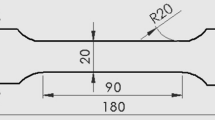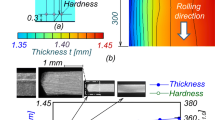Abstract
The present paper presents numerical and experimental comparative studies between the conventional bending process (bending using punch and V-die) and bending with a rubber-pad cushion. In fact, a finite-element method is introduced to compare these two procedures used to bend AA1050-H14 Aluminum thin sheet. An elastoplastic constitutive model with quadratic yield criterion of Hill 48 and isotropic hardening behavior has been adopted in FE simulations performed using ABAQUS explicit. To model rubber material, a Mooney–Rivlin theory is used in the finite-element simulation. The purpose of this study is to see the difference between the two methods in terms of effort evolution, springback, stress distribution, thinning. Analyze the effect of the rubber material; in fact, natural rubber, and polyurethane with hardness 50, 70, and 90 shore A are investigated. This numerical study was validated by an experimental investigation that proved the efficiency of the elastic cushion to bend in a better way this thin aluminum sheet.















Similar content being viewed by others
References
Giuseppe S (2001) A numerical and experimental approach to optimize sheet-stamping technologies: part II-Aluminum alloys rubber forming. J Mater Des 22:299–315
Alberti N, Forcellese A, Fratini L, Gabrielli F (1998) Sheet metal forming of titanium blanks using flexible media. CIRP Ann Manuf Technol 47:217–220
Dirikolu MH, Akdemir E (2004) Computer aided modelling of flexible forming process. J Mater Process Technol 148:376–381
Peng L, Hu P, Lai X, Mei DQ, Ni J (2009) Investigation of micro/meso sheet soft punch stamping process-simulation and experiments. J Mater Des 30:783–790
Quadrini F, Santo L, Squeo EA (2010) Flexible forming of thin aluminum alloy sheets. Int J Mod Manuf Technol 2:79–84
Liu Y, Hua L (2010) Fabrication of metallic bipolar plate for proton exchange membrane fuel cell by rubber pad forming. J Power Sources 195:3529–3535
Sun Y, Wan M, Wu X (2013) Wrinkling prediction in rubber forming of Ti-15-3 alloy. Trans Nonferrous Met Soc China 23:3002–3010
Belhassen L, Koubaa S, Wali M, Dammak F (2016) Numerical prediction of springback and ductile damage in rubber-pad forming process of aluminum sheet metal. Int J Mech Sci 117:218–226
Ramezani M, Mohd Ripin Z, Ahmad R (2009) Computer aided modelling of friction in rubber-pad forming process. J Mater Process Technol 209:4925–4934
Browne DJ, Battikha E (1995) Optimization of aluminum sheet forming using a flexible die. J Mater Process Technol 55:218–223
Chen L, Chen H, Guo W, Chen G, Wang Q (2014) Experimental and simulation studies of springback in rubber forming using aluminum sheet straight flanging process. Mater Des 54:354–360
Arnet H (1999) Advanced technology of plasticity. In: Proceedings of the sixth ICTP pp 2349
Kwon HC, Im YT, Ji DC, Hrhee M (2001) The bending of an aluminum structural frame with a rubber pad. J Mater Process Technol 113:786–791
Yoon SJ, Yang DY (2003) Development of a highly flexible incremental roll forming process for the manufacture of a doubly curved sheet metal. CIRP Ann Manuf Technol 52:201–204
Shim DS, Yang DY, Han MS, Chung SW, Kim KH, Roh HJ (2008) Experimental study on manufacturing doubly curved plates using incremental rolling process. In: Proceedings of the 9th International Conference on Technology of Plasticity, Gyeongju pp 887–888.
Li MZ, Hu ZQ, Cai ZY, Gong XP (2007) Method of efficient continuous plastic forming for freeform surface part. J Jilin Univ 37:489–494
Lee JW, Kwon HC, Rhee MH, Im YT (2003) Determination of forming limit of a structural aluminum tube in rubber pad bending. J Mater Process Technol 140:487–493
Liu Y, Hua L, Lan J, Wei X (2010) Studies of the deformation styles of the rubber-pad forming process used for manufacturing metallic bipolar plates. J Power Sources 195:8177–8184
Chen L, Chen H, Guo W, Chen G, Wang Q (2013) Experimental and simulation studies of springback in rubber forming using aluminum sheet straight flanging process. J Mater Des 54:354–360
Liu H, Zhang G, Shen Z, Zhang W, Wang X (2017) Investigation of micro-bending of sheet metal laminates by laser-driven soft punch in warm conditions. Micromachines 8:224
Jin CK, Jeong MG, Kang CG (2014) Fabrication of titanium bipolar plates by rubber forming and performance of single cell using TiN-coated titanium bipolar plates. Int J Hydrogen Energy 39:21480–21488
Mars J, Ben Said L, Wali M, Dammak F (2018) Elasto-plastic modeling of low-velocity impact on functionally graded circular plates. Int J Appl Mech 10(4):1850038
Bouhamed A, Jrad H, Ben Said L, Wali M, Dammak F (2019) A non-associated anisotropic plasticity model with mixed isotropic–kinematic hardening for finite element simulation of incremental sheet metal forming process. Int J Adv Manuf Technol 100:929–940
Ben Said L, Mars J, Wali M, Dammak F (2016) Effects of the tool path strategies on incremental sheet metal forming process. Mech Ind 17:411
Ben Said L, Mars J, Wali M, Dammak F (2017) Numerical prediction of the ductile damage in single point incremental forming process. Int J Mech Sci 131–32:546–558
Koubaa S, Mars J, Wali M, Dammak F (2017) Numerical study of anisotropic behavior of Aluminum alloy subjected to dynamic perforation. Int J Impact Eng 101:105–114
Koubaa S, Belhassen L, Wali M, Fakhreddine Dammak F (2017) Numerical investigation of the forming capability of bulge process by using rubber as a forming medium. Int J Adv Manuf Tech 92:1839–1848
Autay R, Koubaa S, Wali M, Dammak F (2018) Numerical implementation of coupled anisotropic plasticity-ductile damage in sheet metal forming process. J Mech 34:417–430
Wali M, Chouchene H, Ben Said L, Dammak F (2015) One-equation integration algorithm of a generalized quadratic yield function with Chaboche non-linear isotropic/kinematic hardening. Int J Mech Sci 92:223–232
Mars J, Wali M, Jarraya A, Dammak F, Dhiab A (2015) Finite element implementation of an orthotropic plasticity model for sheet metal in low velocity impact simulations. Thin Walled Struct 89:93–100
Belhassen L, Koubaa S, Wali M, Dammak F (2017) Anisotropic effects in the compression beading of aluminum thin-walled tubes with rubber. Thin-Walled Struct. https://doi.org/10.1016/j.tws.2017.08.010
Wali M, Autay R, Mars J, Dammak F (2016) A simple integration algorithm for a non-associated anisotropic plasticity model for sheet metal forming. Int J Numer Methods Eng 107:183–204
Ben SL, Belhassen L, Mars J, Wali M (2018) On the use of NC milling and turning machines in spif process of asymmetric parts: numerical investigation. Design and modeling of mechanical systems—III: CMSM 2017: lecture notes in mechanical engineering. Springer, Cham
Ben SL, Wali M, Dammak F (2015) Numerical simulation of incremental sheet metal forming process. Multiphysics modelling and simulation for systems design and monitoring. MMSSD 2014. Applied condition monitoring. Springer, Cham
Hill R (1948) A theory of the yielding and plastic flow of anisotropic metals. Proc Roy Soc Lond A 193:281–297
Acknowledgements
The authors extend their appreciation to the Deanship of Scientific Research at King Khalid University for funding this work through research groups program under grant number (R.G.P.1/68/40).
Author information
Authors and Affiliations
Corresponding author
Ethics declarations
Conflict of interest
The authors have no conflict of interest.
Additional information
Publisher's Note
Springer Nature remains neutral with regard to jurisdictional claims in published maps and institutional affiliations.
Rights and permissions
About this article
Cite this article
Said, L.B., Wali, M., Khedher, N. et al. Efficiency of rubber-pad cushion in bending process of a thin aluminum sheet. J Rubber Res 23, 89–99 (2020). https://doi.org/10.1007/s42464-020-00040-0
Received:
Accepted:
Published:
Issue Date:
DOI: https://doi.org/10.1007/s42464-020-00040-0




